Hidden figures: Tom Midwood, caricatures and Tasmanian Railway Records

Sometime in the 1990s it came to the attention of the National Archives (then responsible for Tasmanian railway records) that a large collection of railway plans was languishing in haphazard storage at the Inveresk Railyards in Launceston. Archivists were dispatched to investigate and encountered a chaotic situation. Records had been stored anywhere and everywhere, including stuck up a disused chimney! Many had been badly affected by the 1929 floods and by the incursion of soot from coal-fired steam engines. However, the collection was one of marvellous significance, documenting Tasmania’s railway infrastructure. The archivists made a case for the preservation of this collection and secured funding to perform the mammoth task of cleaning, organising and properly storing the recovered hoard. In the process they found something quite unexpected.
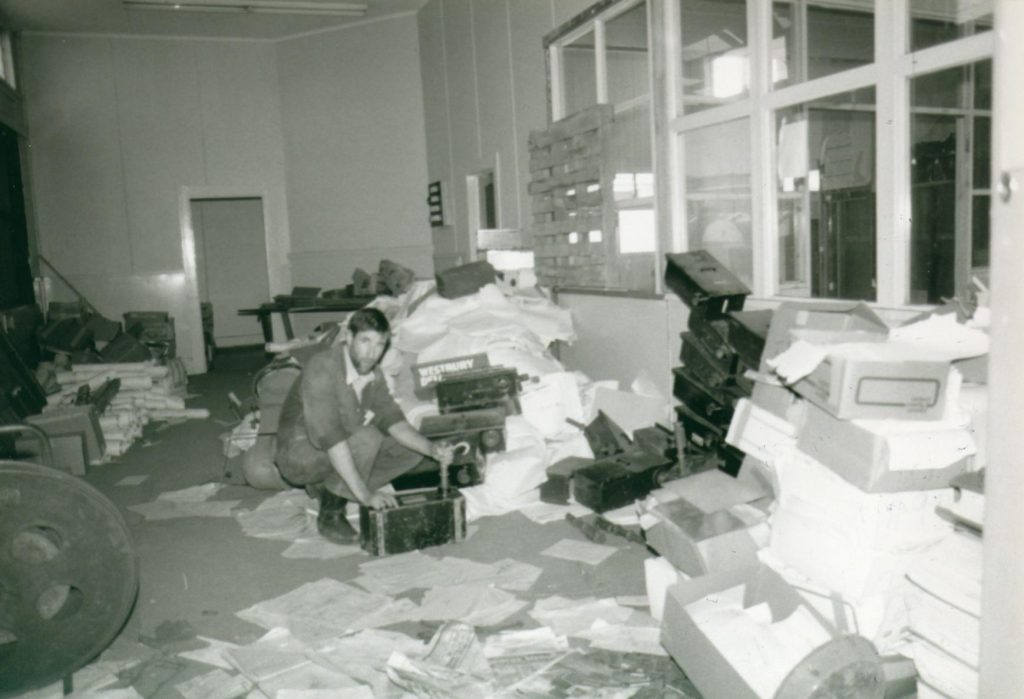
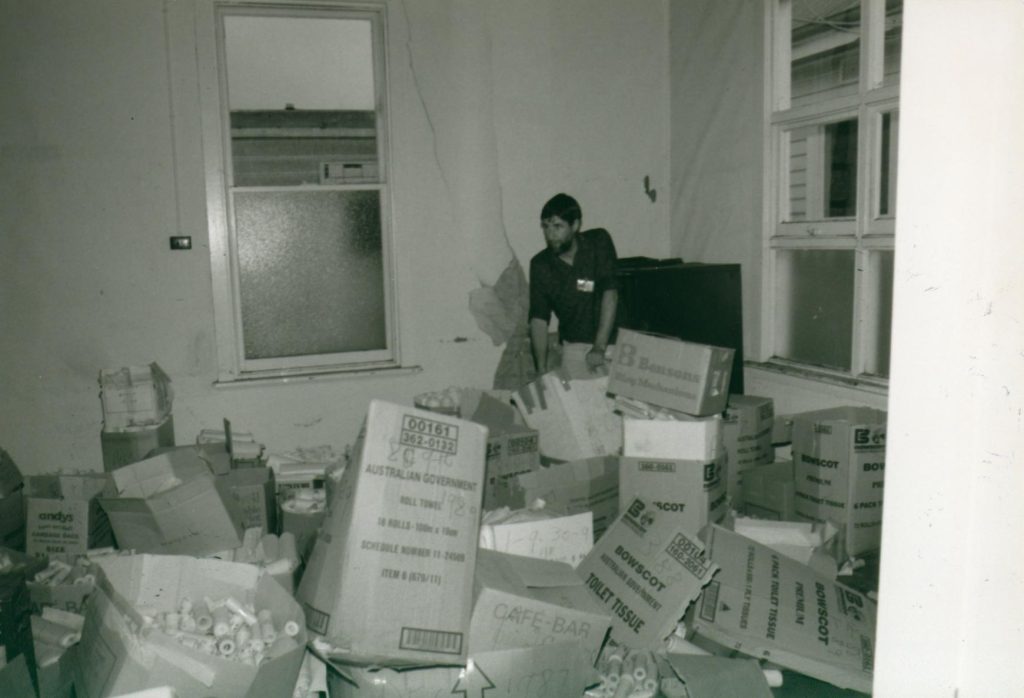
While performing conservation works on a linen plan of the Mersey and Deloraine Railway, a technician made a wonderful discovery. The plan stretched all the way down and across her worktable, and as she was leaning close to clean the surface she cried out in surprise. There, under her magnifying glass, in the curls of ink detailing the trees along the track sidings, was a face…and a hand, waving at her! She leaned closer. Many of the trees were ordinary and lifeless, but then – there! – two bearded gentlemen smoking pipes! Another face and waving arm! Another waving figure with a roman nose! And over there, a long nose and a prominent brow…pursed lips and a suggestion of whistling.
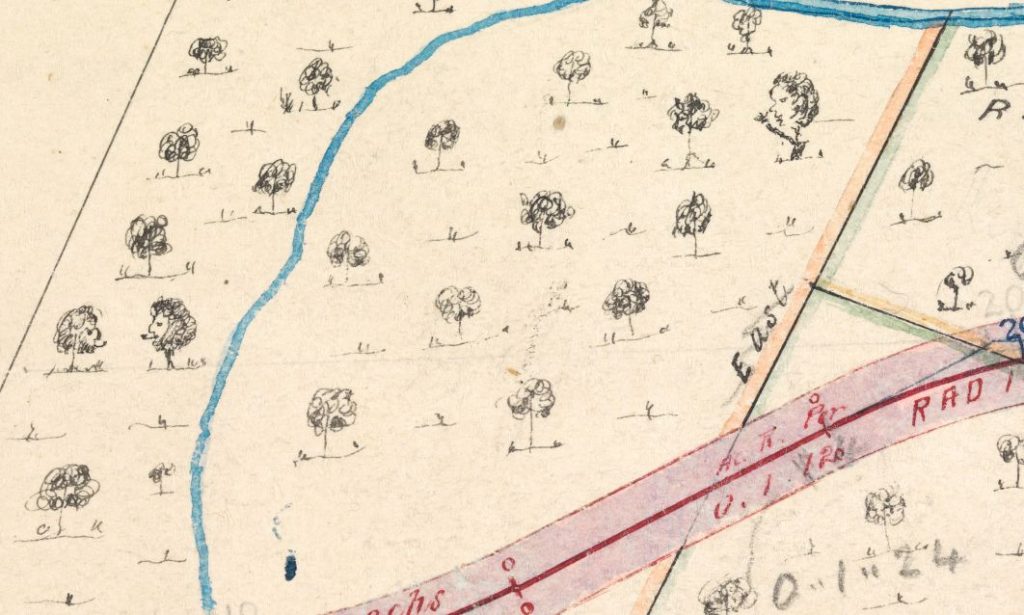
Plan detail, Plan 7812539 (11634) [TGR] – plan of the Mersey and Deloraine Railway from Deloraine to the junction with the Latrobe Tramway [includes human caricatures hidden in the tree drawings, by Thomas Midwood], 1875, Tasmanian Archives: P1330/1/1591
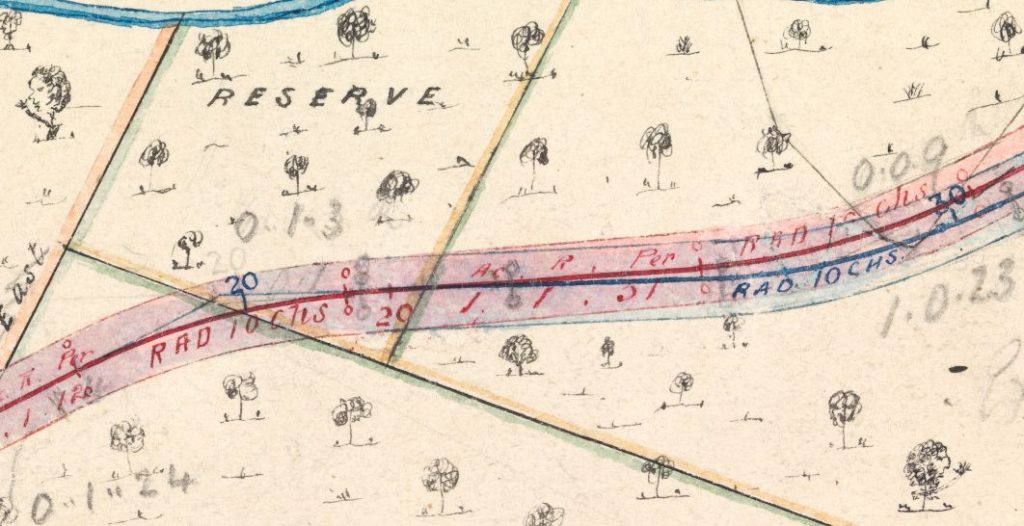
She paced up and down the long worktable, scanning the trees with a magnifying glass for more characters. Most of the trees were topped with the usual squiggle of foliage, but then…was that the face of a chicken? A hairstyle? A judge’s wig? She noticed that one area of the grass was arranged in a heart-shape! Over here, a tree had legs, and was that a singing lady? Colleagues crowded around, making their own gasps of surprise and fascination as they saw the tiny caricatures hidden in the drawing. Of all the technical drawings recovered, only this one was found to include such illustrations.
Tasmania’s railway records were all transferred from the custody of the National Archives to the Tasmanian Archives in 2010, after the railway operations and infrastructure reverted to full state-ownership in 2009. Our digitisation team has recently made high resolution copies of this plan for the first time, so that anyone can examine these enchanting details.
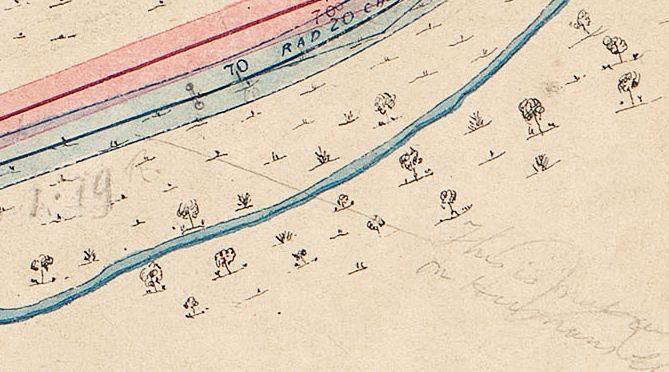
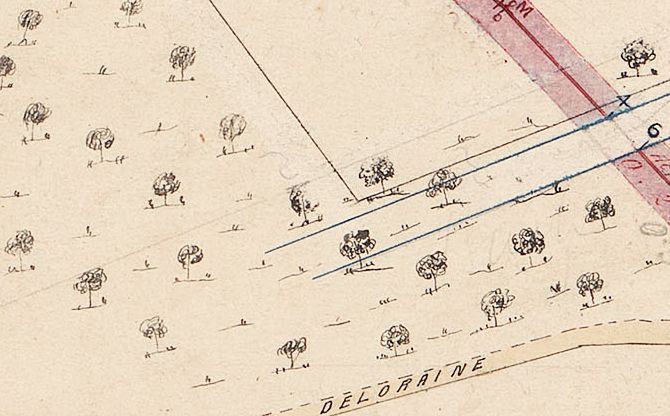
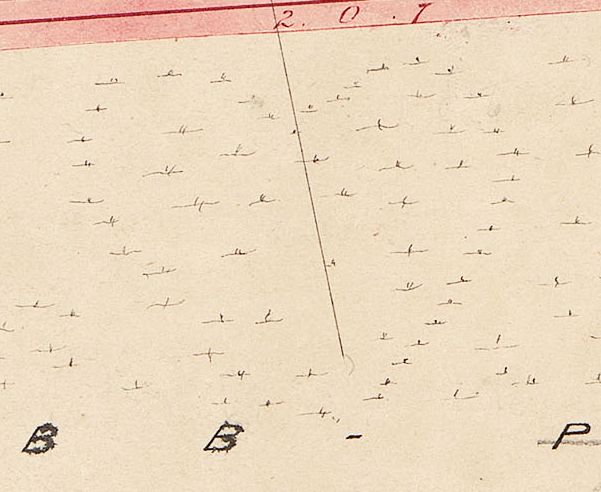
While we don’t know who first identified the artist responsible for these drawings, the style marks it as the work of Thomas Claude Wade Midwood. Midwood was ‘one of the best-known and best-liked men about the city’ of Hobart – a caricature artist, musician and, crucially, draftsman for the Public Works Department. The drawings, and the calligraphy are in his distinctive hand.
Tom Midwood was born into an upper-middle-class family in Hobart in 1854. His father Edwin was a clerk in the Police Office, and Tom was educated at Hutchins School from the age of 9. Although he easily obtained work in the Public Service, working at the Melbourne Post Office for a short time in the 1870s, young Tom Midwood soon went to sea to explore the world and his artistic talents. In addition to honing his drawing skills, we know that he toured as a musician in the United States ‘for he was quite a master of the banjo, guitar and mandolin, besides being a fair pianist’.
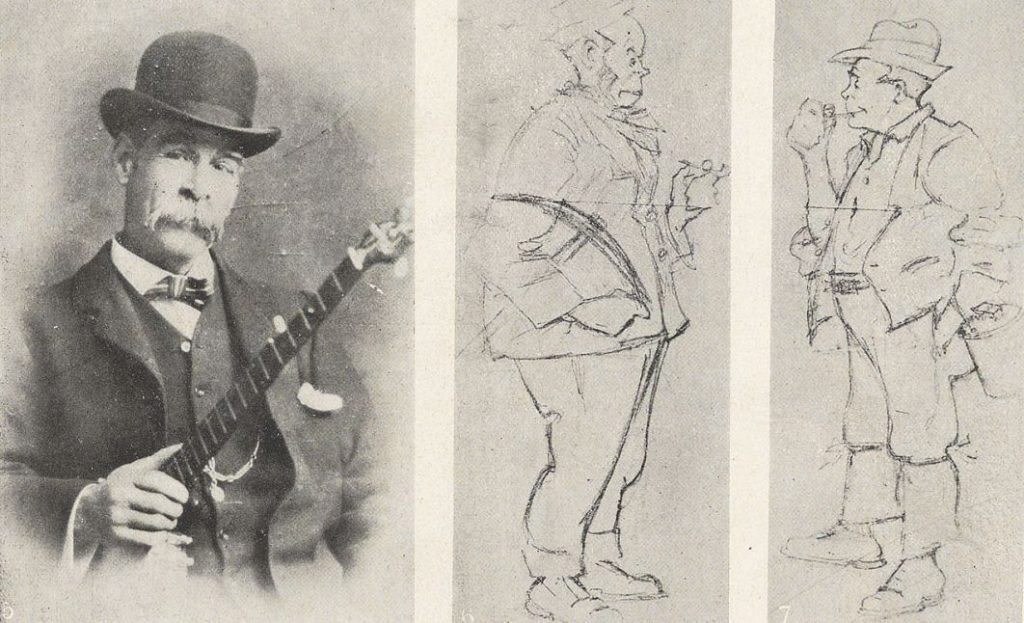
Midwood returned to Tasmania after his travels and continued drawing. The first reference I could find to his cartoons in the Tasmanian press is in 1879 when an artist named Hugh Fisher, who was performing ‘Instantaneous Portraiture’ at the Theatre Royal, acknowledged the ‘assistance he has received from Mr Thos. Midwood’s cartoons’. This suggests that Midwood’s drawings of local personalities were circulating in some form by this time, and highlights the public appetite to see an amusing likeness of a public figure. The main thrill of these images would have been the moment of recognition of a familiar face, furthered by any cheeky references to the person’s known interests or associations.
Much of the comedy is lost on a modern-day observer, as we lack that knowledge of local personalities and their interests or foibles. Through the cartoons that have made their way to the State Library and Archives collections we can see the drawings he produced for public and private audiences. While it is possible to piece together some elements of humour in the drawings of prominent figures, it is hard to know whether you’ve truly got the joke.
A lithograph print ‘Well known citizens of Southern Tasmania’ gives us a number of Midwood’s popular drawings.

Midwood, Thomas Claude Wade, ca. 1889-1890? ‘Well known citizens of southern Tasmania’, Allport Library and Museum of Fine Arts, Libraries Tasmania: HA1066
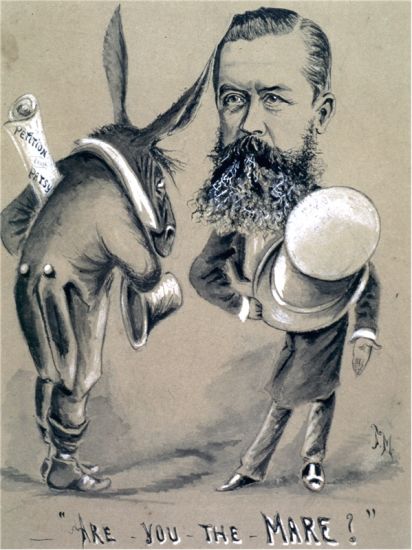
Midwood, Thomas Claude Wade, ca.1880, ‘[James Harcourt] “Are you the Mare?”‘, Allport Library and Museum of Fine Arts, Libraries Tasmania: FA314
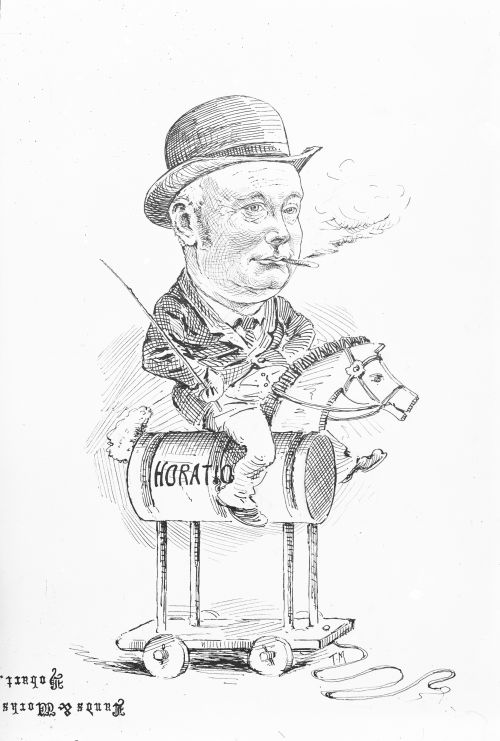
Midwood cartoon, ca. 1900, Tasmanian Archives: NS1013/1/195
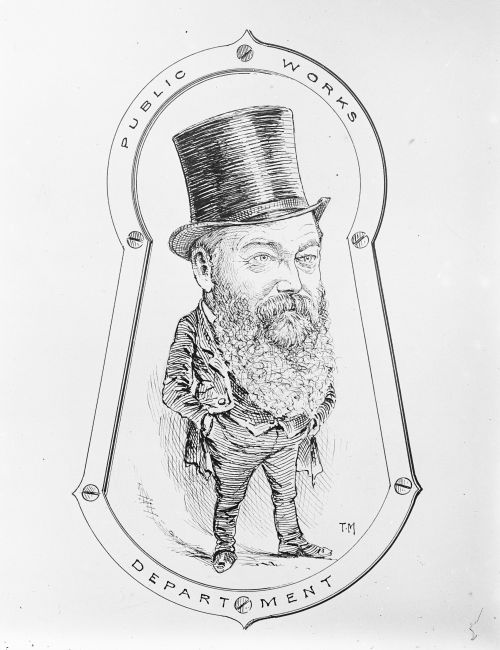
Midwood cartoon, ca. 1900, Tasmanian Archives: NS1013/1/199
Not a lot is known of Midwood’s career between his arrival back in Hobart, presumably in the late 1870s and the late 1880s. Some of his original drawings are dated circa the 1880s, but I have not found any advertisements for, or publications of, his work that clearly date to this period. As a freelancer he probably relied on his personal connections to obtain work, but it is unclear whether his primary income came from selling cartoons and graphic art or from working as a contract draftsman. For more than a decade Midwood seems to have avoided taking up a permanent job in the public service.
Midwood married Beatrice Hewitt in 1883, when he was 29 and she was ‘under 21’. She was the daughter of the chief clerk of the Customs Department, and therefore an equal in terms of social class. They went on to have two sons and two daughters, nearly all of whom were born in the 1880s. Perhaps he spent this decade indulging his hobbies of drawing, woodcarving, music, and sailing, and enjoying his young family. This may also have been the period in which he built his portfolio of drawings that were later lithographed and celebrated in print. In 1887 Anson Brothers produced an advertising album featuring his cartoons, which seems to be the first major appearance of his work in print.
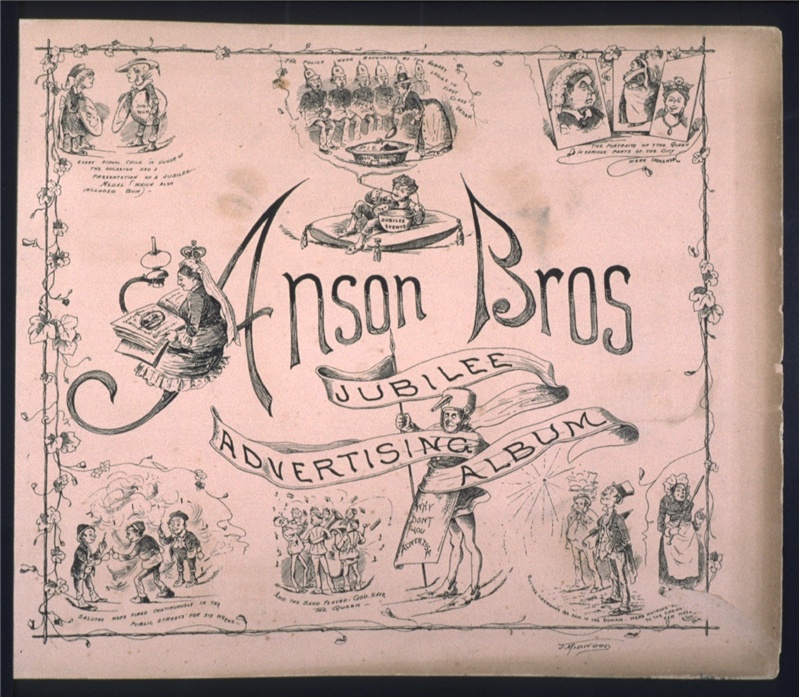
The railway plan on which Midwood left his mark started its life around 1875, in the Surveyor General’s Office (around the time Tom Midwood was playing banjo in America). Midwood probably did not work on it until around 1890, the year they were signed off by the Engineer-in-Chief’s office of Public Works. There is one other known example of Midwood’s work as a draftsman for the Public Works Department, and this is also from 1890 (Craig, 1984; Tasmanian Archives: PWD266-1-99). It must be assumed, as he had no formal appointment to the department at this time, that he did this work on contract.
One other drawing exists that ties Midwood to the railways. In 1886 a train derailed at the Ring Culvert near Brighton. The driver was killed, and two railway workers and several passengers were seriously injured. The passengers were all politicians and dignitaries on their way to the opening of the Fingal Railway line. The crash and the subsequent inquest were extensively covered in the newspapers. The Launceston paper The Tasmanian even published an illustrated supplement the week after the event. Midwood also produced a drawing of the event, perhaps with thoughts of having it published in a similar way. It is, arguably, the most serious of all his drawings, and appropriately so. Still, his reputation was for humorous drawings – this may have given an editor misgivings about using his work in a serious context. There is no evidence that his drawing was ever published.

By the time our railway plan was produced, Midwood was finally getting some traction as a professional cartoonist and graphic artist. In the last weeks of 1890, The Mercury advertised a Christmas promotion offering ‘Tom Midwood’s cartoon with every Christmas copy’ of The Tasmanian Mail (unfortunately this cartoon was not preserved with the State Library’s run of the Mail). In 1892 Midwood was the feature artist in the debut issues of the Hobart Critic (Oct 1892-Apr 1893). However, by the time a new issue of that paper was published in March 1893, Midwood was not involved. Midwood was travelling to Sydney at this time. Perhaps he got some ideas for monetising his art on that trip because by September of 1893 he had returned and produced an illustrated directory of Hobart’s businesses.
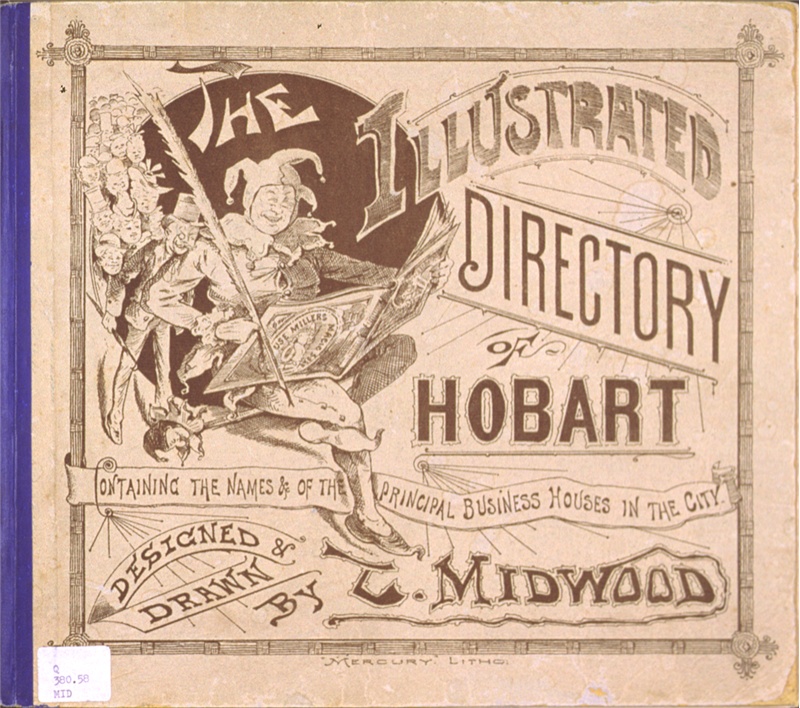
Tom finally took up his first formal appointment to the Lands and Surveys Department in 1895, as a clerk (Statistics of the State of Tasmania for the year…). He was promoted to draftsman for Lands and Works in 1899 and kept this position until his death in 1912.

In their obituary of Midwood in the Critic newspaper, a friend who ‘knew him from a boy’ reflected that although ‘his ability as a draughtsman was admitted’, ‘his artistic tastes were smothered by a dead level, mediocre atmosphere which converts one to an unthinking machine.’ The obituarist further states that Midwood was ‘brought prominently before the public in various ways in the general caricaturing line, but he never received anything like an adequate remuneration for his splendid talents. One is inclined to think that he never improved much on his early work.’ The sentiment that public servants were not well paid was also articulated in this poem, published in the last issue of Critic that Midwood illustrated.
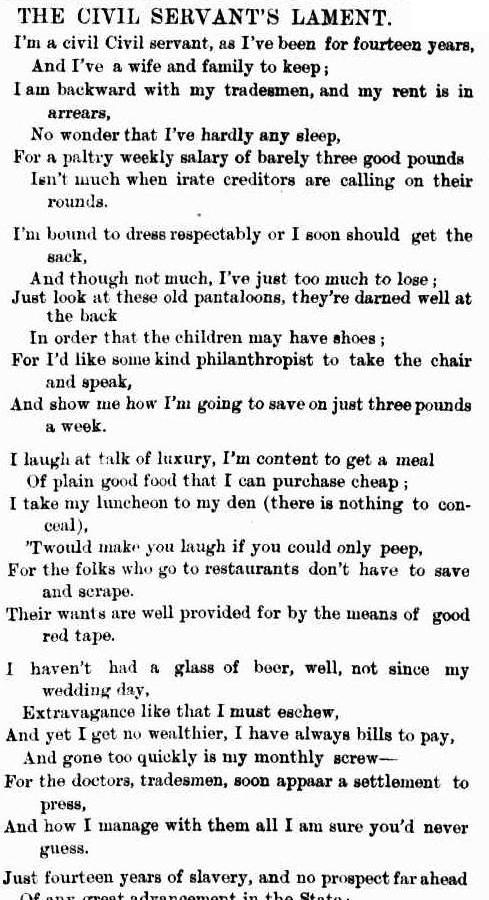
It is hard not to see the faces in the trees as evidence of that artistic suffocation in progress. We might imagine Tom drawing these characters in the trees while sitting in a dusty government office for hours on end, having completed the careful technical work, bored with detailing yet another tiny tuft of grass and squiggle of tree. The subtlety of this decoration suggests something of a professional rebellion. At arms-length they are indistinguishable from the other trees, so they could have been overlooked by a supervisor. However, they must have brought about a chuckle or two from a railway employee closely inspecting details along the line.

Further Reading
Craig, Clifford, More Old Tasmanian Prints, (Launceston: Foot and Playsted, 1984).
The Mercury, ‘Serious Disaster on the Main Line’, 30/6/1886, <https://trove.nla.gov.au/newspaper/article/149533873>.
University of Tasmania, Thomas Midwood, 1854-1912, online exhibition, 2008: <https://www.utas.edu.au/library/exhibitions/midwood/index.html>


Hi, my name is Tim, I have a collection of Tom Midwood illustrated letters (10), and also a silk flyer kept from the 1895 arrival of the Duke of Edinburgh at the Welcome to Appleland Arch designed by Tom.
While they have been in my family for years there is no relationship with the Midwoods. Would these be of interest to anyone, or could they be added to a display?
Your thoughts
Kind regards Tim Hannaford
Hi Tim
That sounds fantastic! Please submit the form at this link and someone from our Collections department will get back to you about this. https://libraries.tas.gov.au/about-us/our-collections/tasmanian-heritage-collections/add-to-our-tasmanian-heritage-collections/collection-offers/
Fascinating story. Thank you Jess. What a character, and brilliant artist. Maybe the train derailment drawing wasn’t published because it was a bit too gruesome, with the person’s head squished under a derailed (coal?) truck!
Hi Jess, great story. I have the original hand written documents listing the costings/labour and materials for the construction of the Mersey Deloraine train line. I saved them from the rubbish skip during renos (back in 1980) at the old sandstone building on the corner of Davey Street Hobart and Salamanca Place. They were found up in the ceilings where they were “boarded” in a long time ago.
Happy to pass them on if interested /
Thank you Greg. If you could submit this form with details of the records, someone in our Collections team will be in touch: https://libraries.tas.gov.au/about-us/our-collections/tasmanian-heritage-collections/add-to-our-tasmanian-heritage-collections/collection-offers/
Excellent article – thanks for putting his wonderful work online.
A wonderful article, particularly the aspects regarding the railway map and the civil servant’s poem.